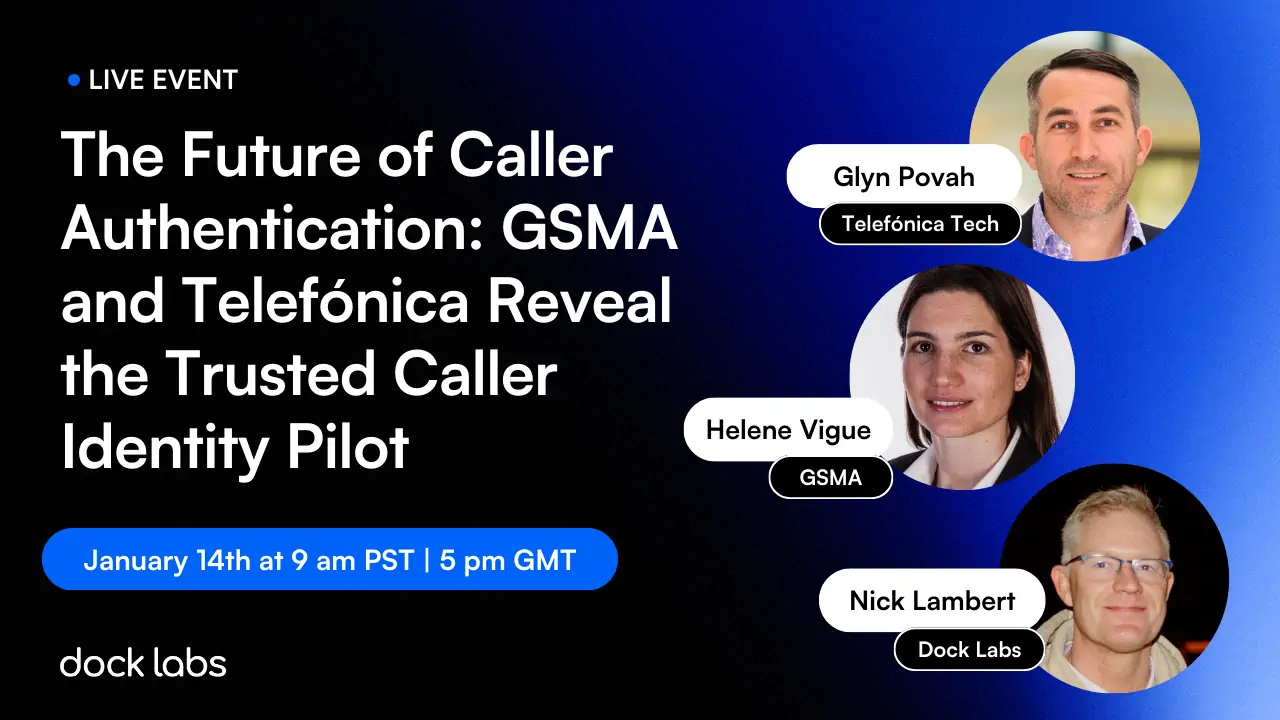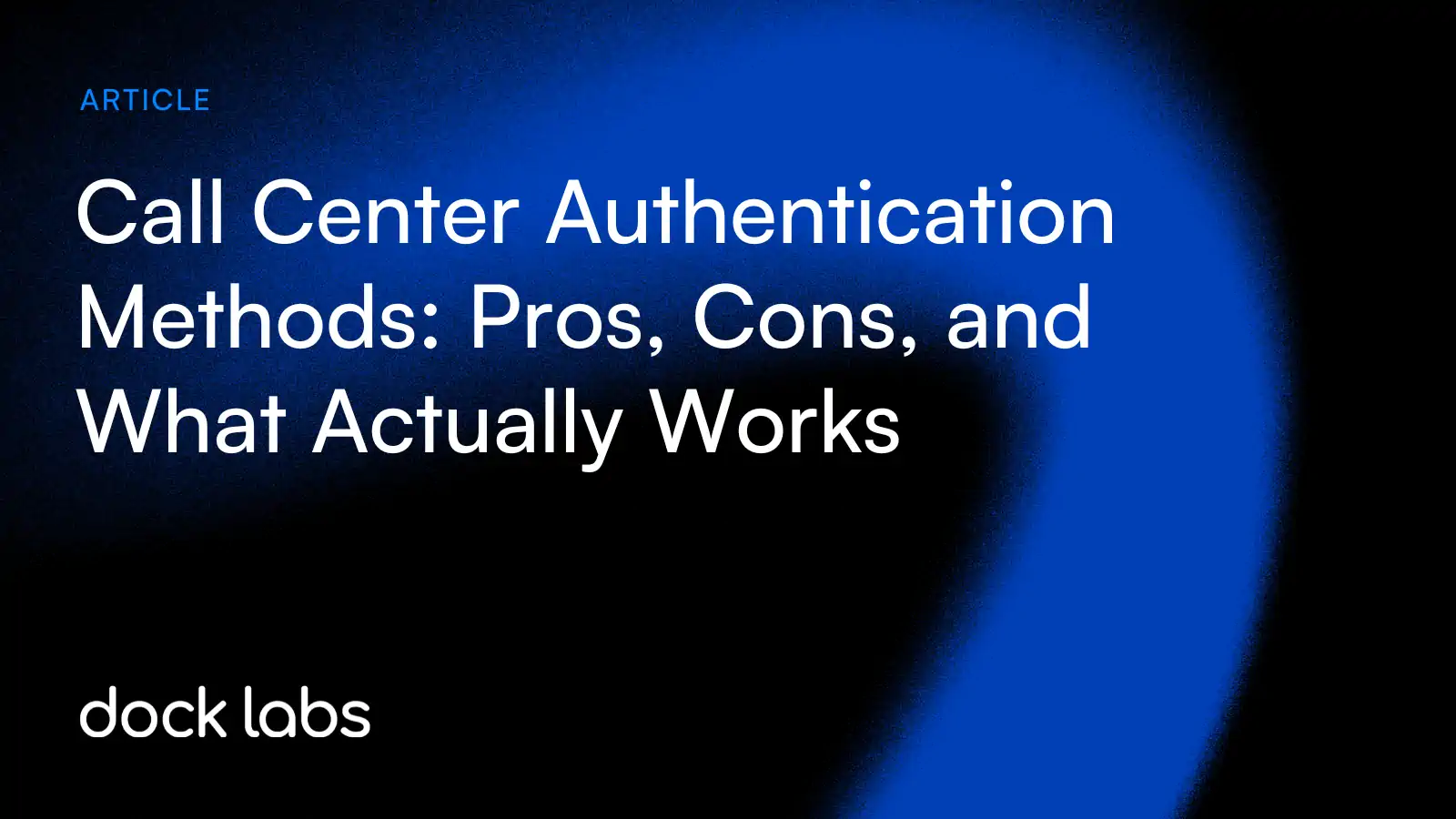Every call to your contact center begins with the same question: Who is this, and can we trust them? The answer, how you authenticate that caller, can either stop fraud in its tracks or open the door to costly breaches and poor customer experiences.
Call centers face a unique challenge: they must verify identities in real time, often with limited context and under pressure to keep calls short. For years, most organizations relied on knowledge-based authentication (KBA) or one-time passwords (OTPs), but today, those methods are increasingly vulnerable to phishing, SIM swap attacks, and data leaks.
In this guide, we’ll break down the major authentication methods used in contact centers today. You’ll learn how each one works, where it helps, where it falls short, and what to consider when designing a more secure and seamless authentication experience for your customers.


Why Call Center Authentication Matters More Than Ever
Fraud is getting smarter, and call centers are increasingly in the crosshairs. As organizations tighten security in digital channels, attackers are shifting to the voice channel, where identity checks are often weaker, and human agents can be manipulated.
This matters for three big reasons:
1. The cost of fraud is rising.
From account takeovers to unauthorized SIM swaps, voice-based attacks can lead to serious financial losses, reputational damage, and customer churn.
2. Bad authentication = bad experience.
Asking customers to repeat personal details or recite one-time codes creates friction and frustration. It extends handle time, drives up support costs, and sends the message that your company doesn’t trust its users.
3. Privacy and compliance pressures are growing.
Regulations like GDPR place strict limits on how personal data is collected and handled. When agents ask callers to speak sensitive information out loud, organizations increase their exposure, both legally and operationally.
Effective caller authentication isn’t just a security task anymore. It’s central to customer trust, regulatory risk, and operational efficiency. That’s why choosing the right method, and knowing its tradeoffs, matters more than ever.
Overview of Common Call Center Authentication Methods
There’s no one-size-fits-all approach to caller authentication, but understanding the major methods is the first step toward choosing the right one for your contact center. Below, we explore five widely used authentication techniques, how they work, and where they succeed or fall short in today’s threat landscape.
Knowledge-Based Authentication (KBA)
KBA involves asking the caller to confirm known details, like their date of birth, address, or answers to security questions. It’s familiar and easy to deploy but highly insecure in today’s environment.
- Strengths: Simple to set up; no tech required on the caller’s end.
- Weaknesses: Data can be easily breached or guessed; frustrating for users; puts PII in front of agents.
- Use Case Fit: Low-risk accounts; legacy systems.
- Fraud Risk: High
One-Time Passwords (OTPs) via SMS or Email
OTPs add a second step to the process by sending a code to the caller’s device or inbox. They’re widely used, but not always reliable.
- Strengths: Familiar to users; adds a barrier beyond KBA.
- Weaknesses: Vulnerable to SIM swap, email hacks, phishing; only confirms device access.
- Use Case Fit: Mid-risk flows where the device is assumed secure.
- Fraud Risk: Moderate
Voice Biometrics
Voice biometrics use unique vocal characteristics to identify the caller, either passively (during conversation) or actively (via a spoken phrase).
- Strengths: Can be passive and fast; no need for codes or data sharing.
- Weaknesses: Can be fooled by deepfakes or recordings; false positives; quality affected by noise or illness.
- Use Case Fit: Supplementary factor in well-controlled environments.
- Fraud Risk: Moderate
Verifiable Credentials via Digital ID Wallet
A newer and much more secure method lets callers prove who they are using your company’s mobile app. When they call, they get a notification in the app asking them to confirm their identity with a fingerprint or Face ID. Once they do, the agent instantly sees that the caller is verified, without needing to ask any personal questions or send codes.
- Strengths: Highest level of assurance; phishing-resistant; protects privacy.
- Weaknesses: Requires app adoption and some initial setup.
- Use Case Fit: High-risk flows; organizations with existing apps (e.g. banks, telcos).
- Fraud Risk: 🟢 Low
What to Consider When Choosing a Call Center Authentication Method
Not all authentication methods are created equal, and not every method fits every use case. When selecting the right approach for your call center, consider these key factors:
What types of call center fraud are you trying to prevent?
Different methods block different threats. If you’re worried about SIM swaps or phishing, SMS OTPs won’t be enough. If social engineering is your top concern, minimizing the agent’s role in verification becomes critical.
How much friction can your users tolerate?
The more steps or confusion you add, the longer your handle times, and the more likely customers are to get frustrated or abandon the call. Aim for low-friction flows that don’t sacrifice security.
Are you verifying the person or just their device?
Many methods (like OTPs) prove someone has access to a phone, but they don’t confirm who is using it. For high-risk flows, you need identity-level assurance, not just device-level.
What are your privacy and compliance obligations?
The more personal data your agents handle or hear, the greater your exposure under regulations like GDPR. Choose methods that reduce or eliminate PII handling wherever possible.
What systems and channels are already in place?
The ideal solution builds on what you already have, like your mobile app or IVR, without adding complex integrations. Look for flexible call center authenticaton solutions with APIs and SDKs that work within your existing tech stack.
Evaluating these trade-offs will help you strike the right balance between security, user experience, and operational feasibility.
Real-World Use Case: Telefónica’s Modern Authentication Pilot
To test a better way to verify callers, Telefónica, one of the world’s largest telecom providers, partnered with GSMA, TMT ID and Dock Labs on a pilot project, and the results showed what secure, seamless authentication can look like in practice.
Instead of asking customers to answer security questions or recite codes, the pilot used a mobile app-based approach. When the customer called the contact center, they received a push notification. To confirm their identity, they simply unlocked the app with their fingerprint or Face ID. That action instantly verified them to the call center, without sharing any personal data over the phone.
The results?
- Authentication took just a few seconds
- Agents didn’t need to ask for personal details
- Fraud risk was significantly reduced
- Customers had a smoother, more trusted experience
And importantly, this solution can be embedded into a company’s existing mobile app (e.g. a bank or telecom app), so customers don’t need to download anything new, it simply becomes part of the experience they already trust and use.
Modernizing Your Call Center Authentication Methods
Bringing your contact center authentication up to the best practices of modern security and experience standards doesn’t require starting from scratch. The key is to shift from outdated, vulnerable methods to approaches that are faster, more secure, and privacy-conscious, ideally using the digital tools your customers already engage with.
Here’s how forward-thinking organizations are making that transition:
Turn your app into your authentication hub
If your company has a mobile app, such as a banking or telecom app, it can become the most secure place for a call center to authenticate customers. By embedding tools like push notifications, biometrics, and verifiable credentials, you create a trusted channel that fraudsters can’t easily mimic or manipulate.
Reduce reliance on agents for identity checks
When agents are responsible for asking questions or interpreting answers, fraud risk goes up. Offloading authentication to pre-call workflows (like a push prompt during IVR) protects the business and improves efficiency.
Use stronger signals than phone numbers or passwords
A phone number can be spoofed. A password can be guessed or stolen. But biometrics and secure credentials tied to a known device are much harder to fake, and much easier for customers to use.
Design with privacy and compliance in mind
Minimize how much personal data is spoken aloud or stored. Verifying someone’s identity without exposing sensitive information reduces your compliance burden under regulations like GDPR.
Support fallback flows but steer users toward stronger methods
You don’t have to eliminate all legacy options on day one. But you can prioritize stronger methods like app-based verification, and use others (like OTPs or agent checks) only as a backup. Over time, this gently shifts user behavior while protecting more sessions.
Modernizing your call center authentication stack isn’t just about preventing call center fraud, it’s about building trust, speeding up support, and respecting your customers’ privacy from the very first second of the call.
Key Takeaways
- Call centers remain a key target for fraud due to weak or outdated authentication methods.
- Traditional approaches like KBA, OTPs, and even voice biometrics are increasingly vulnerable to phishing, SIM swaps, spoofing or deepfakes.
- A wide range of authentication methods exist, each with tradeoffs in security, user experience, and implementation complexity.
- Verifiable credentials offer the strongest protection, especially when embedded in your organization’s mobile app and combined with biometrics.
- In a pilot with one of the world’s largest telecom providers, Telefónica, this approach proved faster, more private, and far more secure, eliminating the need for agents to handle personal data.
- The best path forward is to shift authentication outside of the call conversation, minimize human judgment, and use tools customers already trust.
FAQ: Call Center Authentication Methods
1. What is the most secure authentication method for call centers?
Verifiable credentials combined with biometrics inside your company’s mobile app offer the strongest protection. They’re resistant to phishing, SIM swaps, and spoofing, and they keep personal data out of the call flow.
2. Are one-time passwords (OTPs) still safe to use?
They’re better than nothing, but far from foolproof. OTPs can be intercepted through SIM swap attacks or phishing. They also only prove control of a device, not the caller’s identity.
3. What’s the problem with security questions (KBA)?
KBA relies on static personal details that are often exposed in data breaches or easy to find online. Fraudsters can guess or script their way through, especially with leaked data.
4. Do I need to build a new app to support better authentication?
No. Solutions like verifiable credentials can be embedded directly into your existing mobile app using SDKs. Customers don’t need to install anything new.
5. Can I still support fallback methods like OTPs?
Yes, but they should be secondary. Use stronger authentication methods by default, and reserve OTPs or KBA for backup when needed. This reduces fraud exposure while maintaining accessibility.






